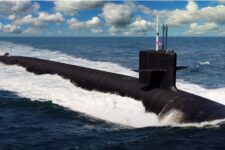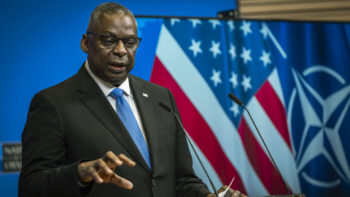
The French operational experience in and off of Libya has neatly dovetailed with that of the U.S. Marines and suggests a way forward for American thinking about littoral operations.
With the decision of the U.S. national command authority to “lead from behind,” the Marines were almost inadvertently given a leading role. What “lead from behind” meant operationally was that the U.S. was not going to commit significant combat air capabilities to the fight, so the F-22 returned from Middle East exercises and the aircraft carrier in the Mediterranean was sent elsewhere, to support US ground troops in Afghanistan. The U.S. was to provide a C2 package to support the operation, as well as ground attack capabilities such as A-10s and C-130 gunships. Most importantly, the U.S. provided airborne tanking and related air support to the allied operations.
This piece is really all about the performance of the Marines and the US Navy-Marine amphibious ready group team. What the ARG ended up doing was re-shaping the next phase of operational history. The recently departed Secretary of Defense confused amphibious with Inchon, whereas the ARG really is a seabase from which one can conduct a variety of operations across the spectrum of warfare.
The ARG is in the throes of fundamental change, with new ships and new planes providing new capabilities. These new capabilities are nicely congruent with the Libyan operational experiences. Given the Marines battle hymn, it seems that “off the shores of Tripoli” can have a whole new meaning for the evolution of the US force structure.
The ARG was used in several unprecedented ways in the Libyan operation. First, the V-22 Osprey was a key element of changing how U.S. forces operated. The Osprey provided a logistical linchpin which allowed the ARG to stay on station and allowed the Harriers to generate greater sortie generation rates and ops tempo. The use of the Osprey in the operation underscored the game changing possibilities of the ARG in littoral operations of the future.
For the Marine Expeditionary Unit, the combat elements might be on the ship, might be ashore, or might be in transit. The challenge for the MEU commander is to be able to concentrate force on the task at hand. Prior to the Libyan operations, Col. Dessens, the 26th MEU commander, faced the challenge of assembling his capability to fight the battle and then to be able to flexibly change the mix of forces at sea. What this meant was that some of his Ospreys were in Afghanistan, and not on his ARG ships.
The key point here is that the sea base, which in effect the ARG is, can provide a very flexible strike package. Given their proximity to shore, the Harriers could operate with significant sortie rates against enemy forces. Not only could the Harriers come and go rapidly, but the information they obtained with their Litening pods could be delivered to the ship and be processed and used to inform the next strike package. Commanders did not need a long C2 or C4ISR chain to inform combat. This meant that the ground forces of Gadaffi would not have moved far from the last positions Harriers noted before the new Harriers moved into attack positions. This combination of compressed C4ISR and sortie rates created a deadly combination for enemy forces and underscored that using sea bases in a compressed strike package had clear advantages over land-based aircraft several hours from the fight dependent on C4ISR coming from hundreds or even thousands of miles away.
One more point about the ARG’s operations. The Osprey and the Harrier worked closely together to enhance combat capabilities. One aspect of this was the ability of the Osprey to bring parts and support elements to the Harriers. Instead of waiting for ships to bring parts, or for much slower legacy rotorcraft to fly them out, the 300-mph Osprey could bring parts from land bases to keep the ops temp up of the Harriers.
The well known pilot rescue mission certainly highlighted how a vertically-launched aircraft working with the Osprey off of the ARG can create new capabilities. The elapsed time of authorization to the recovery of the pilot and his return to the USS Kearsarge was 43 minutes.
This rescue took place even though the US Air Force had a rescue helo aboard the USS Ponce. In my view, having discussed this with the relevant personnel, it was not used for two reasons. It would have gotten to the pilot much later than an Osprey team and the command and control would have been much slower than what the Marines could deliver. The key to the Marines’ C2 was that the pilots of the Ospreys and Harriers planned the operation together in the ready room of the USS Kearsarge. They did not meet in virtual space. They exchanged information in real time and were in the same room. They could look at the briefing materials together. The Harriers were informed by fresh intelligence ABOARD the USS Kearsarge. The sea base brought together the assets and intelligence to execute the mission.
If we look at the French experience several Libyan lessons can be highlighted. First, the centrality of leveraging multiple bases in a littoral operation is significant. The French used several land bases and incorporated the sea base – whether the carrier or their amphibious ships – to work with land-based aircraft. The U.S. Marines used their land base largely to supply the sea-based air ops via Ospreys. Second, having the C4ISR forward-deployed with the pilot as the key decision maker is crucial to mission success.
The classic Air Force CAOC system was challenged by what the Marines demonstrated in the operation; the French experience reinforces that lesson. In a recent story from London on Breaking Defense, the point was made that some French pilots felt the release authority from Predator information was too slow. The interpretation was unhappiness with the US, but I would argue that it is more the case that the information in a fluid and dynamic situation must be provided in a more timely fashion than a system built for 1991 air operations permits. Third, new air capabilities make a significant difference. For the Marines, the Osprey was the game changer in this operation. For the French, it was the new recce pods off of the Rafales. Fourth, the dynamic targeting problem discussed in the first article was also highlighted by the USMC experience. Getting accurate information from the ground is central to operations.
The USN-USMC team has a number of new capabilities being deployed or acquired which will
enhance their ability to do such operations. The F-35B will give the Marines an integrated electronic warfare and C4ISR capability. The new LPDs have significant command and control capabilities. The new LCS could provide — along with the Osprey — significant combat insertion capability for ground forces and rapid withdrawal capability.
For the French, UAVs could become wingmen for the Rafaels. Also, the role of C2 capabilities of the new amphibious ships were underscored as well. Fifth, the pick-up quality of this operation may become more a norm than an aberration in the future. The old paradigm of days or weeks of significant planning and then roll out of a fleet of C4ISR aircraft and other capabilities may be challenged.
Deploying air assets that can be tapped by the sea base to shape an operation may become a key requirement for future battles on the littoral. As with any operation, each one’s characteristics are unique and thus not predetermined. What the Marines and the French forces have demonstrated is that 2011 certainly is not Iraq 1991 or Bosnia 1996.
Anduril’s Aussie drone sub ‘one year early and on budget,’ heads to production
Defense Industry Minister Pat Conroy said Anduril’s Ghost Shark is part of the Australian military’s $5.2 billion to $7.2 billion investment in undersea uncrewed maritime systems.


























